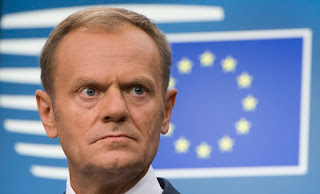In this first post we are going to introduce the formation of the European Council,which begins informally with the creation of the European Union. We're going to take a look at the evolution of the council following the major historical events of this organization. Please note that the events mentioned are related only to the European Council or have some influence on it.
- 22 July 1951 - The Paris Treaty: the European Coal and Steel Community(ECSC) it's created in order to form a common market for coal and steel and to release tensions between the european countries after WWII. Members:West Germany,France,Belgium,Luxembourg and Netherlands.

Signing of the Paris Treaty(1951)
- 1 January 1958 - Treaties of Rome: the European Economic Community is formed. It's main aim is the economic integration of it's member states.
- 1 January 1973 - New members: Denmark, Ireland and United Kingdom join the EEC,expanding the organization up to 9 members.
- 9 December 1974 - Creation of the European Council: after the Copenhagen summit(1973) which stated that summits should be help whenever necessary, the Paris summit creates the European Council. Its aim was to establish an informal forum for discussions between heads of states or governments.

Paris summit 1974
- 11 March 1975 - The first meeting of the European Council takes place in Dublin. The discussion focused on budgetary and economic issues.
- 14 June 1985 - Schengen Agreement: the agreement that eliminates borders control is signed by 5 member states.
- 2 December 1985 - The European Council reaches a political agreement opening the way for the adoption of the Single European Act.
- 11 December 1992 - the council reunites in Edinburgh and agrees to launch public debates and deliberations.
- 1 November 1993 - The Treaty of Maastricht: the European Council acquires a formal status and becomes the provider of political guidelines of the EU.
- 1 January 1996 - Since this date the Council meets at least four times a year.
- 13 December 1997 - Creation of the Eurogroup: endorsed by the European Council, the Eurogroup brings together the financial ministers of the countries whose currency is the Euro.
- 1 May 1999 - Amsterdam Treaty: the Schengen Agreement is introduced in the EU law and the Secretary-General of the Council becomes High Representative for Common Foreign Security Policy.

Amsterdam Treaty
- 1 January 2002 - The euro enters circulation replacing national currencies.
- 1 February 2003 - Treaty of Nice: the Council is reformed in order to use qualified majority voting, and to introduce the principle of enhanced cooperation between member states.
- 1 October 2003 - Since October 2003, all formal European Council meetings take place in Brussels.
- 19 November 2009 - Herman Van Rompuy is elected unanimously as the first permanent President of the European Council by the EU heads of state and government.

Herman Van Rompuy
- 1 December 2009 - Lisbon Treaty: this treaty reforms the European Union's structure and the way it functions. In the case of the European Council, this becomes a formal institution with a President that has an official position as opposed to before the treaty.

EU leaders meeting in Lisbon
- 1 March 2012 - The European Council meets and the EU leaders sign the Treaty on Stability, Coordination and Governance in the Economic and Monetary Union (TSCG). This treaty formalizes the Euro Summit.
- 1 December 2014 - Donald Tusk is elected President of the European Council.
- 9 March 2017 - Donald Tusk gets re-elected as head of the council.

Donald Tusk
- 29 March 2017 - UK triggers Article 50 to leave the European Union. In an official statement the European Council declared that they regret UK's decision but are ready to follow the process of separation.
Main source for this article: http://www.consilium.europa.eu/en/history/?filters=2031
Comments
Post a Comment